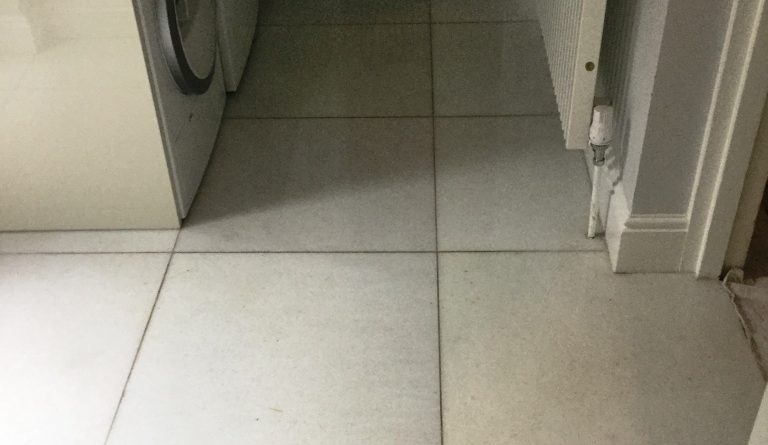Polishing Stains out of Marble Floor Tiles in Northampton
The Marble floor tiles in the pictures below covered a large kitchen, family room and utility area at a property in New Duston near Northampton. The client who was a builder had been recommended our services by one of his own clients, so he contacted us for advice on how to renovate the Marble flooring.

I went to the property to survey the floor and could see straight away that the tiles were dull, lifeless with some staining and hardly recognisable as Marble. I recommended the floor was honed through a polished process known as burnishing, followed by the application of a sealer to provide durable protection for the stone. I organised a quote which was accepted, and we arranged a date for the work to start.

Apologies in advance for the quality of the photographs, it’s tricky this time of year when the light is failing to capture a good photo.
Restoring Polish to a Marble Tiled Floor
I began the burnishing process, which involves the application of a set of Tile Doctor diamond encrusted burnishing pads attached to a 17” rotary machine. At Tile Doctor we work with a four-pad system that allows us to gradually refine the polish on suitable stone floors which generally including Marble, Travertine and Limestone. I started the process by applying a 400-grit coarse burnishing pad lubricated with a little water, working in small sections. Following this, I worked my way through the burnishing system, repeating the process with 800-grit medium and 1500-grit fine grit burnishing pads. I also used some small hand-held burnishing blocks in the difficult to reach corners and edges. The floor is given a quick rinse using a wet pick up machine between pads in order to remove the resulting slurry before starting with the next pad.

I left the floor to dry off overnight to give the Marble tile and grout time to dry and returned the next day to finish the polishing and seal the floor.
Sealing a Marble Tiled Floor
The last 3000-grit pad builds up a high polish on the floor and is applied dry with only a little water squirted on the tiles in a process we call a Spray Burnish. One of the advantages of this method is it leaves the floor dry so is ready for sealing.
Now that I had achieved a good level of shine, I then proceeded to seal the floor to protect the stone against future dirt, stains and damage, which is more common in busy areas of a house like the kitchen. I applied two coats of Tile Doctor Ultra Seal allowing drying time between each coat. This is a no-sheen, natural-look, penetrating sealer which is formulated to provide maximum stain protection, especially in food areas such as the kitchen. Once the sealant had hardened, I ran over the floor with a white buffing pad to further enhance the look of the Marble floor.

The customers were extremely happy with the results and as with all customers I advised on the best maintenance for their floor and provided a complimentary bottle of Tile Doctor Stone Soap to help them maintain the beauty of their floor.
Source: Marble Tile Cleaning and Polishing Service in Northampton, Northamptonshire
